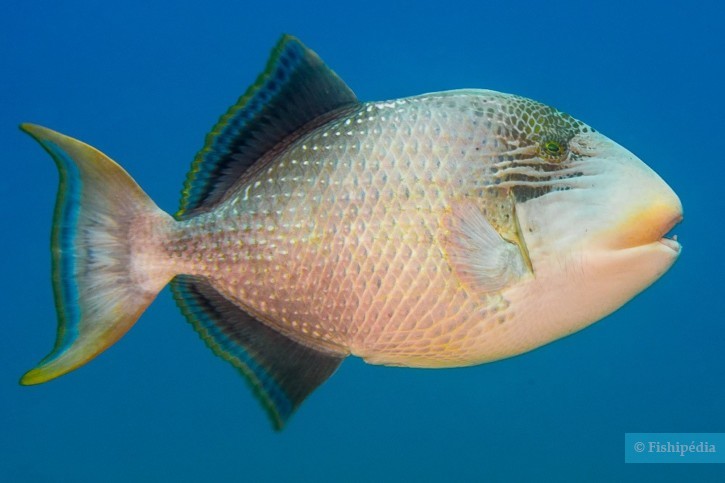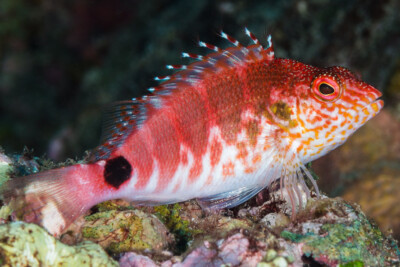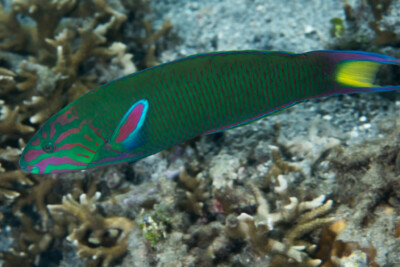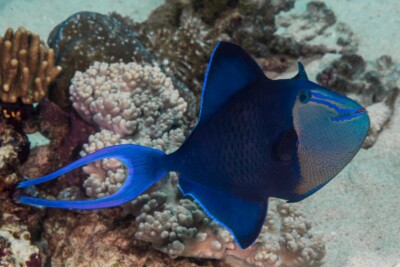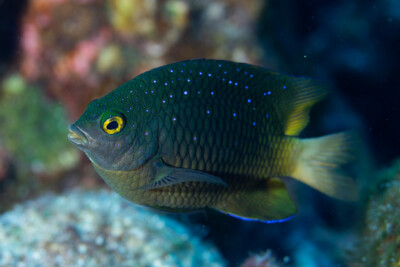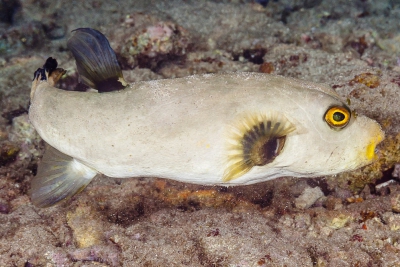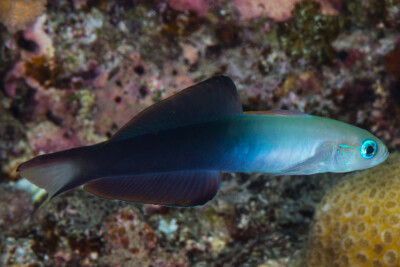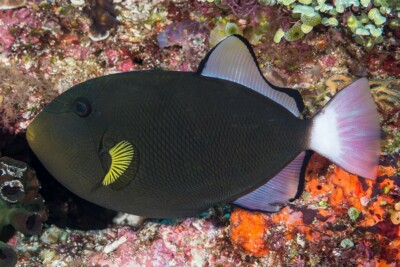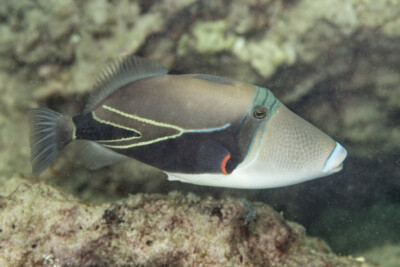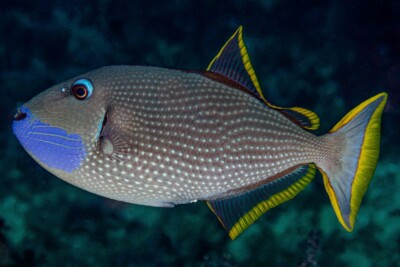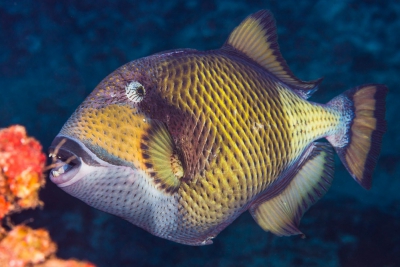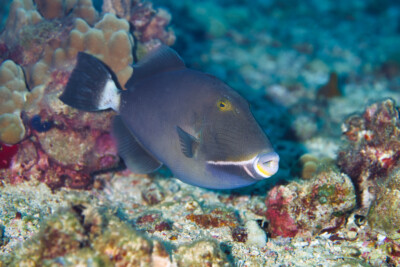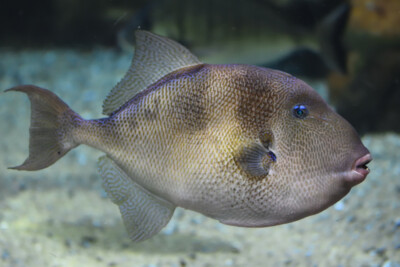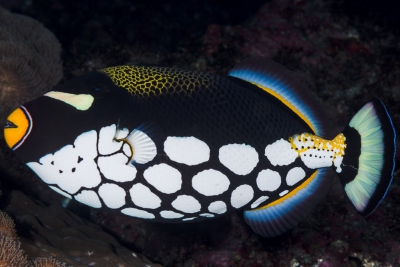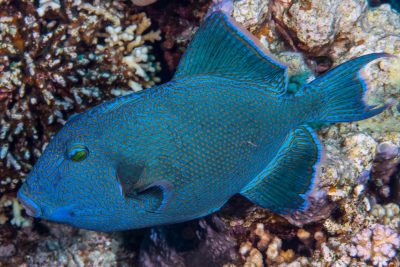yellowmargin triggerfish
| Scientific name | Pseudobalistes flavimarginatus |
|---|---|
| Descriptor | Rüppell |
| Year of description | 1829 |
| IUCN category (World) | LC |
| Family | Balistidae |
| Genus | Pseudobalistes |
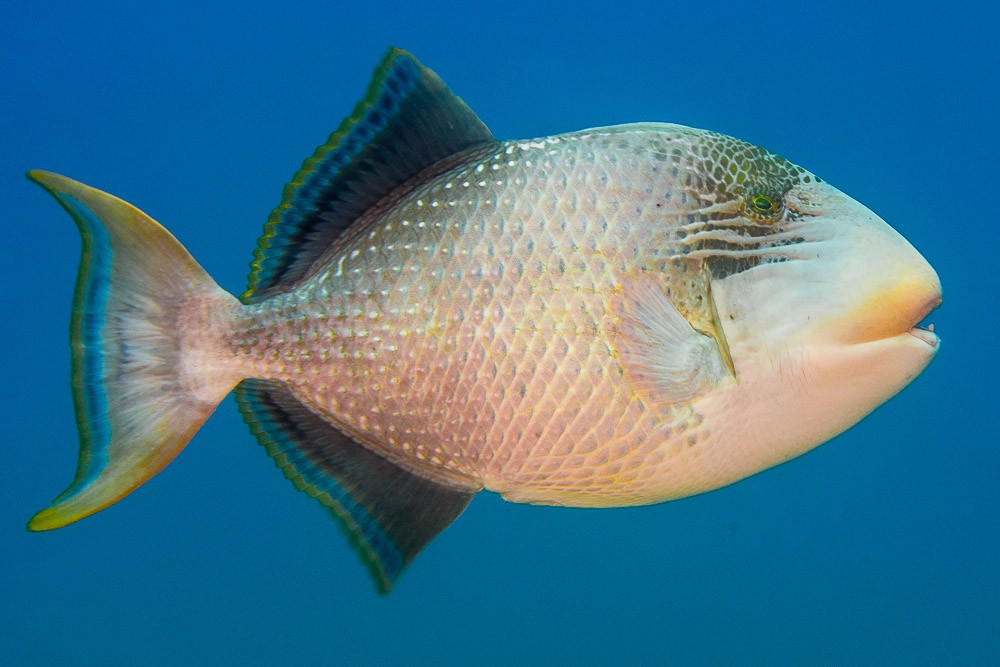

Introduction
Pseudobalistes flavimarginatus, better known as the "yellowmargin triggerfish" due to the coloration of its body, is a fish belonging to the balistidae family.
It is found in tropical waters of the Indo-Pacific. It can be encountered on reefs and estuaries, but can also be found on the slopes and floors of lagoons.
This species, like other triggerfish, are generally calm but during the breeding season they can become aggressive and attack divers who approach their territory.
Some populations consume it fresh, although cases of ciguatera poisoning have been reported. This severe food poisoning is due to their diet, which can sometimes contain toxic algae.
Who is it?
Morphology
-
Type
-
Average size30 cm
-
Maximum size60 cm
-
ShapeOval
-
Patterndrawn scales
-
Type
-
Average size30 cm
-
Maximum size60 cm
-
ShapeOval
-
Patterndrawn scales
How to recognize This fish ?
This triggerfish can reach a length of 60 centimeters. It can be easily recognized by the yellow-orange coloration present in the margins of its anal, caudal, and second dorsal fins.
Its body is oval and laterally compressed, the skin is covered with large and small scales that form a cluster. Like other triggerfish, it undergoes color changes during its development. Juveniles have a yellow belly with dark marbling. Later, they become greenish with black spots and eventually as adults, they lose their marbling to reveal yellow margins surrounding the fins.
The first dorsal spine is formed of three spiny rays, the first of which can be locked in an upright position while the second locks this first one. This mechanism is very useful as a deterrent for predators. It can also use it to find refuge in a cavity and once inside, it unfolds its fin to be protected from currents.
The second dorsal fin has between 24 and 27 soft rays, almost symmetrical to the anal fin. The pelvic fin is reduced to a small protuberance.
The eyes, independent, are small and located very high on the head. The mouth is small relative to the head size, but it is equipped with incisor teeth capable of breaking shells.
Sexual dimorphism
Males are larger than females.
Behaviour & Life cycle
-
dietcarnivorous
-
Sociabilityliving as a couple or alone
-
territorialNo
-
Way of livingdiurnal
Generally, this species is solitary except during the nesting period. Juveniles can be seen in small groups.
Their diet mainly consists of coral branches, gastropods, crustaceans, foraminifera, tunicates as well as sea urchins. They also feed on algae.
Like other triggerfish, it defends its territory during the breeding season and can become aggressive.
Reproduction
-
Reproductionovipare qui pond sur substrat découvert
This fish is oviparous. During the breeding season, males migrate to a spawning area where they establish nesting territories. It takes place in sandy-bottom channels and shallow cuts through the coral reef. Generally, the nest consists of depressions reaching 2 meters wide and 0.7 meters deep.
Then females arrive a few days later and select a male for mating. A female of this species can lay up to 430,000 eggs, in a spongy cluster the size of a fist, weighted down with rubble.
Both parents protect the spawn and provide care but only the females tend to the eggs. The juveniles are pelagic. They remain at the surface, camouflaged in brown algae such as sargassum.
Risks for humans
-
VenomousNo
-
BiteYes
Triggerfish are temperamental fish, especially during the breeding season. They are not afraid to attack swimmers who come near their nest. Unlike weevers, rays, and scorpionfish, this fish is not venomous and only delivers small bites, similar to large piranhas. It is less aggressive than its tropical cousin, the titan triggerfish.
The bites and nips are harmless to swimmers but can be problematic during dives. Indeed, there have been instances where triggerfish have broken the masks of experienced divers at significant depths. Furthermore, triggerfish defend a conical territory from their nest, vertically. Therefore, ascending directly above a nest does not stop the triggerfish from attacking. It is necessary instead to move away to the side.
Origin and distribution

Geographic distribution & Conservation
The species is distributed in tropical waters of the Indo-Pacific, from the Red Sea to South Africa, east through Indonesia to the Tuamoto Islands, and from north to south of Japan.
Like other triggerfish, it is currently threatened by overfishing across much of its range. In several regions, they are still caught before they have had a chance to reproduce.
Conservation status of populations (IUCN)
What is its habitat?
Natural environment characteristics
-
Temperature25 - 29 °C
-
Depth2 - 50 m
Biotope presentation
This triggerfish is commonly found at shallow depths, up to 50 meters.
It inhabits coral reefs but can often be found in brackish waters, estuaries, and lagoons.
Species of the same biotope
To go further
Sources & Contributions
Participation & Validation
The Fishipedia team and specialist contributors are committed to providing high-quality content. However, although the information comes from scientific sources or testimonials from specialists, the cards may contain inaccuracies.

Silvia Gomez
Translation
Translation done with the valuable contribution of our translators, who make this information available to a wider audience. We sincerely thank them for their commitment.
Bibliographic references
Reproductive biology of the masked triggerfish Sufflamen fraenatus - Satish Sahayak - - 2005.
A new record of yellowmargin triggerfish (Pseudobalistes flavimarginatus) (Tetraodontiformes: Balistidae) from the Bay of Bengal of Bangladesh proximity - Alam, M., Sultana, S., & Naser, M. - - 2018.
Territoriality, Reproductive Behavior, and Parental Care in Gray Triggerfish, Balistes capriscus, from the Northern Gulf of Mexico - Simmons, Carrie M; Szedlmayer, Stephen T - BULLETIN OF MARINE SCIENCE, - 2012.
Scientific partners
Tags
Species of the same family
Same genus
Species of the same biotope
